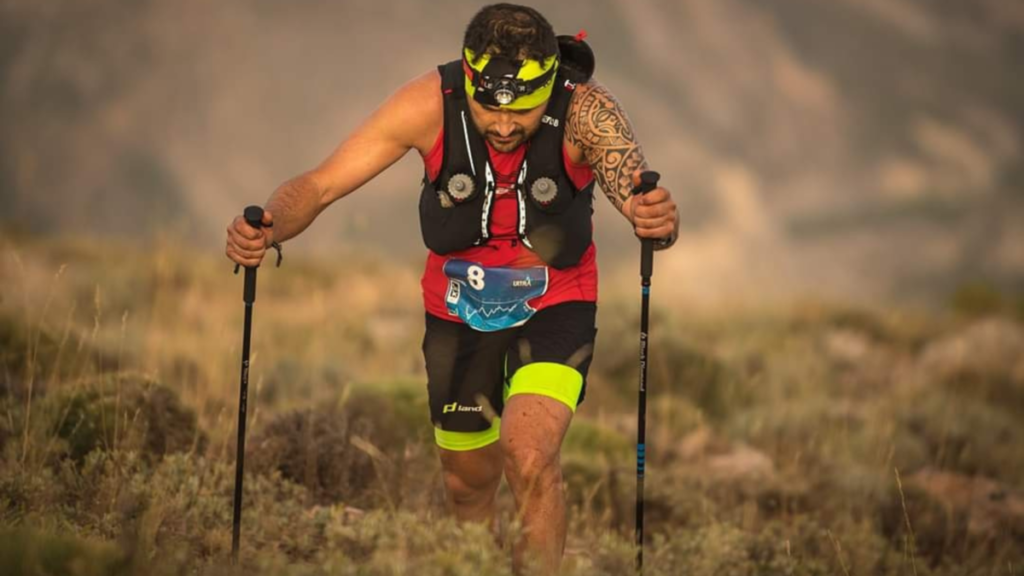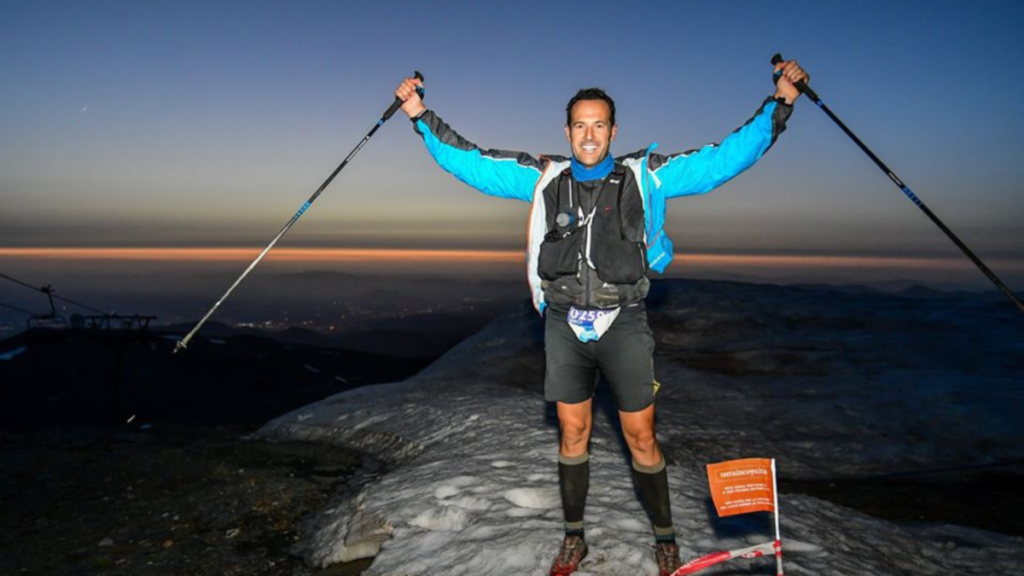
I never considered hiking poles as an option for my trail running until 2007 when I had the opportunity to attend a 10-day climbing/hiking/running workshop in Montserrat, Spain. During that workshop, we were all issued hiking poles and spent time hiking and running over technical ground using hiking poles. What I learned during those 10 days has completely changed how I view hiking poles ever since.
Hiking poles help to distribute the workload more evenly across your upper body and lower body, enhancing your uphill efficiency. Additionally, hiking poles can offer increased stability and control, reducing the risk of slips and falls, and improving downhill control.
Let’s take a closer look at how you can use hiking poles to save energy when trail running over steep and technical terrain.
When To Use Hiking Poles For Trail Running
When considering when to use hiking poles for trail running, it’s important to evaluate the specific scenarios and terrain conditions where they can truly make a difference in your performance and safety.
In challenging uphill terrain, hiking poles can provide invaluable support by helping to distribute the workload more evenly across your upper body and lower body, thus enhancing your uphill efficiency. Additionally, when tackling steep descents, hiking poles can offer increased stability and control, reducing the risk of slips and falls, and ultimately improving downhill control.
Moreover, in rough or technical terrain where obstacles are abundant, hiking poles can aid in maintaining balance and navigating tricky sections with greater ease, contributing to injury prevention. For long-distance trail running, especially on varied terrain, hiking poles can help reduce the impact on your joints and muscles, promoting long-distance endurance.
By incorporating hiking poles into your trail running routine in these specific scenarios, you can enhance your overall performance, safety, and enjoyment of the sport.
Benefits of Using Hiking Poles
Utilizing hiking poles during trail running offers a multitude of benefits that can significantly enhance your overall performance and experience. Firstly, hiking poles provide improved stability, especially on challenging terrain such as steep inclines, rocky paths, or muddy trails. By distributing your weight more evenly and offering additional points of contact with the ground, hiking poles help you navigate tricky sections with greater balance and confidence, reducing the risk of slips and falls.
Secondly, the use of hiking poles can lead to a reduced impact on your joints and muscles. By absorbing some of the shock from each stride, hiking poles help alleviate the strain on your lower body, particularly during long-distance runs or on uneven surfaces. This reduction in impact can contribute to decreased muscle fatigue and a lower risk of overuse injuries, allowing you to maintain your endurance and performance over extended distances.
Lastly, hiking poles can provide increased propulsion on uphill sections, allowing you to engage your upper body muscles more effectively and push off the ground with greater force. This enhanced uphill efficiency can help you tackle steep ascents with more power and speed, ultimately improving your overall trail running performance.
Terrain Considerations
When considering the types of terrain where hiking poles are most beneficial for trail runners, it’s essential to focus on the specific challenges that each terrain presents. Steep inclines, for example, can put a significant strain on your lower body muscles and joints, making it crucial to have the extra support and stability that hiking poles provide. By distributing your weight more evenly and allowing you to engage your upper body in the ascent, hiking poles can help you maintain balance and momentum on steep inclines, ultimately improving your uphill efficiency.

Rocky paths pose another challenge for trail runners, as uneven surfaces can increase the risk of tripping or twisting an ankle. In such terrain, hiking poles offer additional points of contact with the ground, enhancing stability and reducing the impact on your joints. By providing a steady support system, hiking poles can help you navigate rocky paths with greater confidence and control, minimizing the risk of injuries.
Similarly, muddy trails can be slippery and unpredictable, requiring extra caution and balance. Hiking poles can act as anchors in muddy terrain, offering stability and traction to prevent slips and falls. By planting the poles firmly in the ground and using them to test the stability of the terrain, trail runners can negotiate muddy sections more safely and efficiently, ensuring a smoother and more enjoyable running experience.
Uphill Efficiency
When tackling uphill sections during trail runs, hiking poles play a crucial role in enhancing uphill efficiency. By distributing your weight more evenly and engaging your upper body, hiking poles help maintain momentum and conserve energy. The additional support provided by the poles allows trail runners to push off the ground more effectively, propelling themselves forward with each step. This not only aids in reducing the strain on lower body muscles and joints but also improves overall balance and stability on steep inclines.
Moreover, hiking poles enable trail runners to engage their arms and shoulders, effectively sharing the workload between the upper and lower body. This balanced effort helps in preventing fatigue and allows for a more sustainable pace during uphill climbs. By utilizing hiking poles to push off the ground and propel themselves forward, runners can navigate challenging inclines with greater ease and efficiency, ultimately enhancing their uphill performance and endurance.
Downhill Control
When it comes to downhill running, maintaining control and stability is essential to prevent slips and falls, especially on steep or technical terrain. Hiking poles are valuable tools that offer support and balance, allowing trail runners to navigate descents with confidence. By planting the poles firmly into the ground and using them to distribute weight, runners can stabilize themselves and reduce the risk of losing balance on uneven surfaces.
The use of hiking poles during downhill sections also engages the upper body, providing additional support and control. By utilizing the poles to absorb impact and maintain a steady pace, runners can effectively manage their descent and avoid putting excessive strain on their lower body muscles and joints. This balanced effort between the upper and lower body not only enhances control but also helps in preventing fatigue and reducing the risk of injuries.
Overall, incorporating hiking poles into your trail running routine for downhill control can significantly improve your stability, balance, and confidence on challenging descents, ultimately enhancing your overall performance and safety on the trails.
Injury Prevention
When it comes to injury prevention in trail running, the use of hiking poles can be a game-changer. By incorporating hiking poles into your routine, you can significantly reduce the risk of common injuries like ankle sprains or muscle strains. These injuries often occur due to uneven terrain, sudden twists, or overexertion, but hiking poles offer additional support and stability to mitigate these risks.
Hiking poles act as an extension of your arms, providing extra points of contact with the ground to enhance balance and reduce the strain on your lower body. This added stability can help prevent missteps or falls that could lead to injuries. Moreover, by distributing some of the workload to your upper body, hiking poles can alleviate pressure on your legs, decreasing the likelihood of muscle strains or overuse injuries during long runs.
Incorporating hiking poles into your trail running routine not only enhances your stability and balance but also plays a crucial role in injury prevention. By leveraging the support and stability offered by hiking poles, you can enjoy a safer and more sustainable trail running experience, minimizing the risk of common running-related injuries.
Long-Distance Endurance
Long-distance trail running requires not only physical endurance but also strategic planning to sustain energy levels over extended periods. By incorporating hiking poles into your trail running routine, you can enhance your long-distance endurance significantly. These poles serve as valuable tools for distributing the workload across your upper body, thereby reducing the strain on your legs and minimizing fatigue.
When you use hiking poles during long-distance trail running, you engage your upper body muscles more actively, allowing your legs to share the burden of propulsion and stability. This balanced distribution of effort helps to prevent early muscle fatigue and conserves energy reserves for the duration of your run. Additionally, the support provided by hiking poles can assist in maintaining a consistent pace and form, especially during challenging uphill or uneven terrain sections.

Overall, integrating hiking poles into your long-distance trail running endeavors can lead to improved endurance by optimizing energy expenditure and reducing the impact of fatigue on your performance. Embracing this cross-training approach not only enhances your physical capabilities but also contributes to a more sustainable and enjoyable trail running experience.
Cross-Training Benefits
By incorporating hiking poles into your trail running regimen, you can unlock valuable cross-training benefits that go beyond just enhancing your running performance. These versatile tools offer a unique opportunity to engage your upper body muscles, promoting overall strength and coordination.
Using hiking poles while trail running requires coordination between your arms, shoulders, and core muscles, leading to a more balanced and efficient workout. This cross-training approach not only strengthens your upper body but also helps improve your overall stability and posture while running on challenging terrain.
Furthermore, the act of propelling yourself forward with hiking poles can enhance your cardiovascular endurance and calorie burn, making your trail running sessions more effective in terms of overall fitness. By incorporating hiking poles into your routine, you can target different muscle groups and reduce the risk of overuse injuries commonly associated with repetitive running motions.
Overall, the cross-training benefits of using hiking poles for trail running extend beyond the trail, contributing to a more well-rounded fitness regimen that enhances strength, coordination, and endurance.
Training and Technique
When it comes to training and technique for using hiking poles during trail running, mastering the proper grip, pole placement, and rhythm is essential for maximizing their benefits.
First and foremost, ensure a firm but relaxed grip on the poles to maintain control and prevent hand fatigue during long runs. Proper pole placement involves planting them slightly ahead and to the side of your body, allowing for a natural arm swing that complements your stride. This placement helps with stability and propulsion, especially on uneven terrain or steep inclines.
In terms of rhythm, aim for a smooth and consistent cadence that syncs with your running pace. Establishing a rhythmic pattern of pole strikes can help distribute the workload between your upper and lower body, reducing strain and enhancing efficiency. Experiment with different techniques, such as double-poling on flat sections and alternating poles on ascents, to find what works best for you.
By focusing on training and refining your technique with hiking poles, you can improve your overall trail running performance, endurance, and stability, while also reducing the risk of injuries associated with repetitive motion.
Personal Preference and Comfort
When considering whether to use hiking poles for trail running, personal preference and comfort are key factors to take into account. Each trail runner has their own unique running style and comfort level, which can greatly influence the decision to incorporate hiking poles into their outings. Some runners may find that using poles enhances their stability and confidence on challenging terrain, while others may prefer the freedom of running without them.
Individual preferences also come into play when it comes to the overall feel of using hiking poles. Some runners enjoy the added propulsion and rhythm that poles can provide, while others may feel restricted or find them cumbersome. It’s important to experiment with using hiking poles during training runs to determine what feels most comfortable and natural for you.
Additionally, comfort levels can vary depending on factors such as hand size, grip preferences, and overall body mechanics. Finding poles that are the right length, weight, and grip style for your individual comfort can make a significant difference in your trail running experience. Ultimately, the decision to use hiking poles should align with your personal preferences and comfort needs to optimize your performance on the trails.
Environmental Considerations
When considering the impact of using hiking poles on the environment, it’s important to be mindful of how our actions can affect the trails we love. The use of hiking poles can potentially lead to trail erosion, especially in delicate ecosystems or on softer terrain. To minimize this impact, trail runners should be conscious of where they place their poles and try to avoid causing unnecessary damage to the trail surface.
Additionally, when sharing trails with other outdoor enthusiasts, proper etiquette is essential. Being aware of your surroundings and yielding to other trail users when necessary can help maintain a positive trail experience for everyone. This includes being respectful of hikers, bikers, and other runners by giving them space and alerting them to your presence when approaching from behind.
By being environmentally conscious and practicing good trail etiquette, trail runners can help preserve the natural beauty of the trails and ensure a harmonious experience for all outdoor enthusiasts.
When Not to Use Hiking Poles
In certain situations, using hiking poles may not be necessary and could even hinder performance. For example, on flat or well-groomed terrain, where the extra support and stability provided by hiking poles may not be needed, runners might find them more of a hindrance than a help. In such cases, carrying poles could become cumbersome and limit natural arm movement, potentially affecting running efficiency.
Similarly, during short, fast-paced trail runs or races where speed and agility are crucial, relying on hiking poles might slow down the runner and disrupt their rhythm. The added coordination required to use poles effectively could detract from the fluidity of movement needed for quick changes in direction or pace.
Moreover, in crowded trail running events or narrow paths, using hiking poles may pose a safety risk to both the runner and other participants. The swinging motion of poles could accidentally hit nearby runners or cause tripping hazards in congested areas.
Considering these scenarios, it’s important for trail runners to assess the terrain, race conditions, and personal running style to determine when using hiking poles may not be the best choice for optimal performance.
